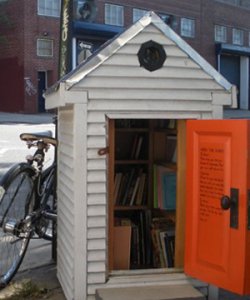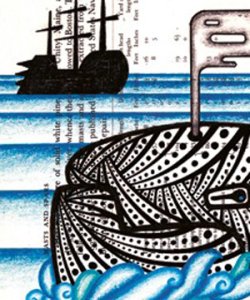Inner Space: Clearing Some Room for Inspiration

What creativity needs most of all is time for the mind to percolate, to mix old ideas together in new ways, and to find connections no one else has found. For this the mind must be left to itself.
Jump to navigation Skip to content
Articles from Poet & Writers Magazine include material from the print edition plus exclusive online-only material.

What creativity needs most of all is time for the mind to percolate, to mix old ideas together in new ways, and to find connections no one else has found. For this the mind must be left to itself.
The newly launched Findings, an online community that lets users compile and contribute excerpts from books and websites, joins a growing number of digital endeavors that place a new emphasis on sharing while reading.

Having chronicled her husband’s sudden death in The Year of Magical Thinking, Joan Didion returns to the subject of loss in a new memoir, Blue Nights, about the subsequent passing of her daughter.
While other social networking sites are useful for playful community-building, LinkedIn provides a place for professional writers to focus on sincerity when creating connections.
With so many good books being published every month, some literary titles worth exploring can get lost in the stacks. Page One offers the first lines of a dozen recently released books, including Aracelis Girmay’s Kingdom Animalia, and Tomaž Šalamun’s The Blue Tower, as the starting point for a closer look at these new and noteworthy titles.

While working on his fourth issue as editor of Poetry Northwest, Kevin Craft, who succeeded David Biespiel in January 2010, discussed the importance of community, as well as a measured approach to editing, to the magazine’s success.

Artist Colin McMullan, founder of the Kindness and Imagination Development Society, has found one way to take the act of sharing that’s become so popular with social media outside the electronic box and into the physical world with his Corner Library project.
Small Press Points highlights the happenings of the small press players. This issue features Exterminating Angel Press, the six-year-old independent book publisher with a big mission: to challenge the received cultural narrative.
Despite the average wired American’s tendency to downsize their character counts, the page counts of newly published books of translated fiction show that the rest of the global literary community may be beefing up.
While U.S. publishers continue their cautious march into the digitization of American titles, the rest of the world is looking to take advantage of other burgeoning markets in Europe, Japan, and beyond.
Literary MagNet chronicles the start-ups and closures, successes and failures, anniversaries and accolades, changes of editorship and special issues—in short, the news and trends—of literary magazines in America. This issue’s MagNet features Memoir (and), Harvard Review, Huizache, the Coffin Factory, Monday Night, and Ploughshares.

In this issue we offer a look at one of the 552 illustrations by Tim Kish, who created a picture a day for each page of Melville’s tome, featured in Moby-Dick in Pictures, published in October by Tin House Books.
CantoMundo, a burgeoning Latino poets workshop in its second year, has become the third organization to make up an unofficial triad aimed at nurturing the work of American poets of color.

Sam Savage wrote for decades and eventually gave up completely before his debut novel was published when he was sixty-five. Now he’s an international best-selling author with a third novel, Glass, published by Coffee House Press, and one simple message for all of us: Art can save you.
Despite the recent collapse of book review sections in newspapers and magazines, the form is still thriving across a variety of venues, from web-savvy publications to local papers.
We’ve compiled this annual guide to graduate creative writing programs—which includes our rankings of the top full- and low-residency MFA programs (with honorable mentions) and, new to this year, doctoral programs—to provide a spark for the deep thinking and serious consideration that the process of choosing a program requires.
Attorney, poet, editor, and freelance journalist Seth Abramson explains the methodology used to compile the Poets & Writers Magazine 2012 rankings of postgraduate creative writing programs.

The top fifteen creative writing doctoral programs in the United States, from the University of Denver in Colorado to the University of Tennessee in Knoxville.
The top ten low-residency MFA programs in the United States, from Warren Wilson College in Swannanoa, North Carolina, to Goddard College in Plainfield, Vermont.
In this regular feature, we offer a few suggestions for podcasts, smartphone apps, Web tools, newsletters, museum shows, and gallery openings: a medley of literary curiosities that you might enjoy. This issue’s 3 for Free features the Poetry Foundation’s new app, Google’s online Art Project, and Project Gutenberg.

Recently released amplified editions of classics such as Jack Kerouac’s On the Road and T. S. Eliot’s The Waste Land indicate that the hybrid format may finally be coming into its own.
Small Press Points highlights the happenings of the small press players. This issue features Arktoi Books, the five-year-old imprint of California-based Red Hen Press that was established in order to open a conversation among lesbian writers.
Directors, coordinators, and professors of full- and low-residency MFA programs offer some advice for prospective students trying to decide which programs are right for them.
With so many good books being published every month, some literary titles worth exploring can get lost in the stacks. Page One offers the first lines of a dozen recently released books, including Terese Svoboda’s Bohemian Girl and Sven Birkerts's The Other Walk, as the starting point for a closer look at these new and noteworthy titles.
Literary MagNet chronicles the start-ups and closures, successes and failures, anniversaries and accolades, changes of editorship and special issues—in short, the news and trends—of literary magazines in America. This issue’s MagNet features the Lucky Peach, Hippocampus Magazine, Shenandoah, Granta, Calyx, and Passager.